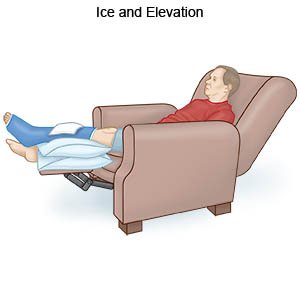Patellar Tendinitis
Medically reviewed by Drugs.com. Last updated on Apr 6, 2025.
What is patellar tendinitis?
Patellar tendinitis is inflammation or irritation of the tendon that connects your kneecap to your shinbone. It may be a short-term condition or develop into a long-term weakness in your knee.
What increases my risk for patellar tendinitis?
- Overuse or sudden increase in activity
- Activities that involve jumping or quick changes of direction
- Lack of flexibility
- Muscle weakness or imbalance
- Sedentary lifestyle
- Certain antibiotics
What are the signs and symptoms of patellar tendinitis?
Patellar tendonitis begins with pain or swelling at your knee. You may feel sharp or aching pain before or after activity. Your condition may progress until you feel pain all of the time.
How is patellar tendonitis diagnosed?
Your healthcare provider will examine your knee and the muscles around your knee. Your provider will ask about your symptoms and when they began. Your provider will also ask if you have recently taken antibiotics or have had a previous knee injury.
- An ultrasound uses sound waves to show pictures of your knee joint on a monitor. An ultrasound may be done to check for the cause of your symptoms.
- An x-ray or MRI takes pictures to show if you have damage in your patellar tendon. You may be given dye to help the pictures show up better. Tell your healthcare provider if you have ever had an allergic reaction to contrast dye. Do not enter the MRI room with anything metal. Metal can cause serious injury. Tell the healthcare provider if you have any metal in or on your body.
How is patellar tendinitis treated?
- NSAIDs , such as ibuprofen, help decrease swelling, pain, and fever. This medicine is available with or without a doctor's order. NSAIDs can cause stomach bleeding or kidney problems in certain people. If you take blood thinner medicine, always ask if NSAIDs are safe for you. Always read the medicine label and follow directions. Do not give these medicines to children younger than 6 months without direction from a healthcare provider.
- Acetaminophen decreases pain. This medicine is available without a doctor's order. Ask how much to take and how often to take it. Acetaminophen can cause liver damage if not taken correctly.
- Injections may reduce inflammation and help your tendon heal.
- Surgery may be needed remove damaged tissue to allow the tendon to heal.
Treatment options
The following list of medications are related to or used in the treatment of this condition.
How can I manage my symptoms?
- Rest your knee so it can heal. Do not begin an activity until directed by your healthcare provider.
- Ice your knee 15 to 20 minutes every hour or as directed. Use and ice pack, or put crushed ice in a bag. Cover it with a towel. Ice prevents tissue damage and decreases swelling and pain.

- Support your knee as directed. Ask your healthcare provider for more information on types of braces that support your patellar tendon and allow it to heal.
- Go to physical therapy as directed. A physical therapist can teach you exercises to stretch and strengthen leg muscles that support your tendon.
When should I seek immediate care?
- You hear a sudden snap or pop or see immediate bruising around your knee.
- You cannot bend your knee or bear weight on your leg.
When should I call my doctor?
- You have a fever.
- You have sudden swelling in your knee.
- Your pain continues or gets worse even after you take pain medicine.
- The skin over your knee becomes red and swollen.
- You have questions or concerns about your condition or care.
Care Agreement
You have the right to help plan your care. Learn about your health condition and how it may be treated. Discuss treatment options with your healthcare providers to decide what care you want to receive. You always have the right to refuse treatment. The above information is an educational aid only. It is not intended as medical advice for individual conditions or treatments. Talk to your doctor, nurse or pharmacist before following any medical regimen to see if it is safe and effective for you.© Copyright Merative 2025 Information is for End User's use only and may not be sold, redistributed or otherwise used for commercial purposes.
Learn more about Patellar Tendinitis
Treatment options
Care guides
Symptoms and treatments
Further information
Always consult your healthcare provider to ensure the information displayed on this page applies to your personal circumstances.
